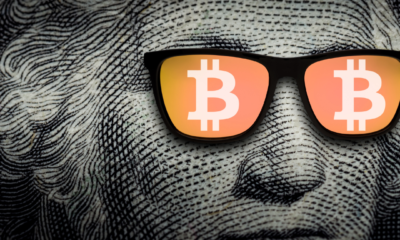Blockchain Events
Crypto’s Great Reset
Published
2 years agoon
By
admin
Five resets have defined Crypto’s history. The first was in 2014, when Mt. Gox, the world’s essentially only bitcoin exchange, fell after a roughly half-billion-dollar attack. The DAO Hack, which occurred in 2016, involved an attacker tricking a smart contract into giving away $60 million worth of Ethereum, which is now worth $8 billion. The third came in January 2018, when the ICO bubble burst, triggering a year-long slide that saw the crypto market lose 60% of its value, or $700 million, primarily in the form of worthless garbage tokens. The fourth occurred in March 2020, when crypto, like most other global financial markets, lost 40% of its value.
Each reset not only increased price-market capitalization but also made room for quick development. Coinbase and Kraken, the two largest exchanges in the United States, sprung from the ashes of Mt. Gox’s collapse because their CEOs saw that users needed safe venues to acquire bitcoin. The implosion of the DAO and the ICO crash laid the framework for today’s expansion of DeFi and the popularity of DAOs.
Last week, the fifth reset began. It has the potential to be the most significant yet. The trillion-dollar market crash this time was triggered by a sharp selloff in risky assets and the abrupt disappearance of LUNA, a $40 billion digital token that backed the $16 billion stablecoin TerraUSD (UST). Unlike the free-floating Luna tokens, each UST was created to be valued at exactly one dollar. The stablecoin lost its peg due to a perfect storm of greed and inadequate technology, and around $56 billion was lost between May 7 and May 12.
At its most basic level, the most recent crypto collapse is another reminder of how get-rich-quick schemes can overwhelm common sense. The loss of so much capital is forcing the industry to reckon with the entire concept of leverage in cryptocurrency markets, forcing it to be honest with itself as to whether innovation is just dressed-up leverage and could be the death knell for an entire category of asset, called algorithmic stablecoins. Dramatic bear market crashes have become all too regular in the embryonic cryptocurrency market. Consider that the US stock market has only had five bear markets in the last century, with stocks falling by more than 30%.
“Leverage can never make a bad investment good, but it can, and often does, make a good investment bad,” argues Mark Yusko, founder of Morgan Creek, an institutional and family investment advising firm. “And so that’s what we’re seeing in the past couple of months, particularly in the past week, just an unwinding of ridiculous levels of leverage. And in the case of the Terra problem from this past week—the Luna problem—it’s just a bad idea, bad structure. You can’t collateralize an asset, that’s supposed to be stable, with an unstable asset.”
The Terra Foundation, based in South Korea, attempted to address this by developing an algorithm that would replace many of the procedures that keep the US dollar stable. When the price falls, an arbitrage opportunity to swap a UST token worth less than a dollar for one dollar of Luna arises. Theoretically.
To put things in perspective, the Great Recession of 2008 was sparked by a housing bubble in which subprime loans were packaged and offered as fresh securities with perfect ratings. Their failure resulted in a loss of market confidence and a domino effect on financial institutions, resulting in potential exposure losses. Similarly, until its demise, stablecoin TerraUSD was supposed to be impregnable. According to Caitlin Long, a former Morgan Stanley managing director who is now building Custodia, a Wyoming-based crypto bank designed from the ground up to make money without leverage, losses were amplified because it was backed by software few understood but piled into because it promised quick riches. So much of what was cloaked as innovation was in fact leverage dressed up as something else,” she explains.
Lightspeed, a Menlo Park-based venture firm with $10 billion in assets under management, and one of Terra’s most prominent investors. Lightspeed is also one of the first venture capital firms to back the cryptocurrency, having invested in Ripple in 2013 and recently increasing their entire crypto holdings to $600 million. A firm spokeswoman sounded defiant when asked about the impact of what will undoubtedly be one of their most infamous investments. “We see this as a computing paradigm shift that is bigger than the ebb and flow of the short-term price of Bitcoin,” the representative explained. “We are doubling down, specifically in infrastructure, DeFi, and emerging use cases.”
Su Zhu, of Three Arrows Capital, another major supporter, remarked on Twitter that LUNA’s failure was due to its execution rather than its basic value proposition. On his Twitter profile, Zhu continues to proudly flaunt the #LUNA hashtag. At the very least, unlike Galaxy Digital founder Mike Novogratz, another major donor, Zhu did not have a Luna tattoo on his arm. He hasn’t said what he wants to do with the ink yet.
The reality is that, while greed played a role in Luna’s demise, its inception was motivated by a wish to preserve crypto’s decentralized ethos, which the burgeoning stablecoin industry had been forsaking. Tether and USD Coin, are the two largest stablecoins by market capitalization, with a combined market capitalization of $126 billion. While they operate on blockchains, they are managed by highly centralized organizations that have been notoriously opaque about the assets used to back their digital currencies. Tether has sparked controversy since it invests 40% of its assets on commercial paper from unknown sources.
Tether was, however, one of the numerous competitors who appeared to benefit from Terra’s demise. In the days following the crash, MKR, the cryptocurrency that underpins the DAI stablecoin, rose 38 percent, and while Tether briefly lost its peg, it swiftly regained its footing, reverting to its role as a relatively safe haven. “In the middle of last week, investors were rotating out of Tether to USDC for all their stablecoin needs,” says Raghu Yarlagadda, CEO of FalconX. “USDC was being bought at 2.5 times the normal rate. Toward the end of the week, what was very interesting was people were rotating out of USDC into fiat.”
Dante Disparte, the chief strategy officer at Circle, was perhaps the most disappointed rival, claiming that Luna’s demise reflected poorly on the entire stablecoin sector, referring to the UST as a “stable-in-name-only” token. Terra creator Do Kwon’s use of more than $3 billion in crypto collateral, he argued, exposed the enterprise as a centralized corporation operating under a decentralized flag.
“The behavior of Terra and its meltdown really, really, really flew in the face of the argument that Terra was totally decentralized because it took a handful of people and a handful of promissory statements on Twitter to either unravel it or to try to save it,” adds Disparte. “And that feels not only centralized, it feels capricious and arbitrary.”
The fact that Luna creator Do Kwon went out of his way to smear competitors didn’t help matters. In March, he stated that watching projects fail was “entertaining,” and that UST would destroy Dai, a similarly built stablecoin established in 2014.
Others, including Yusko and crypto expert Yassine Elmandjra, believe algorithmic stablecoins will never thrive. While most previous crypto resets were caused by technology difficulties that were later resolved and applied by other developers, it appears that the solution, in this case, is already in place: fiat-backed stablecoins. “It’s probably a very humbling realization for a lot of the institutional investors and influencers who were pounding the drum on some of the more experimental initiatives that were going on in crypto,” Elmandjra says. “I think the whole concept of algorithmic stable coins as being a promising project can be put to bed.”
How the market reacts to this abrupt shock will determine how quickly and how these questions are answered. Over the last six months, cryptocurrency has lost more than $1 trillion in value, with bitcoin falling from almost $70,000 to below $30,000. The fact that this could be the first macro crypto bear market in which institutions like Tesla have the asset on their balance sheets adds to the urgency. MicroStrategy, the world’s largest corporate bitcoin holder, is suddenly losing money for the first time ever, with a stockpile of 129,000 tokens at an average purchase price of $30,700.
The good news is that most investors don’t appear to be panicked, which should help to cushion the market’s fall. Ironically, this could be because investors had already begun to withdraw funds when Luna and Terra plummeted. According to Nikolaos Panigirtzoglou, managing director of global markets strategy at JPMorgan Chase, the industry saw “some de-risking in the crypto area even before Terra’s collapse.” “Bitcoin’s mean reversion began in October,” implying that investors began to reduce their crypto investments in late 2021. The direction of these flows will be a good indicator of investor mood in the future.
Another encouraging piece of crypto news is the popular expectation that the Luna/UST meltdown will not propagate throughout the crypto community or into the traditional financial world. Last week, the industry was put to the test when Tether lost its peg on Wednesday morning, plummeting below 95 cents before swiftly recovering. Tether was being shorted by investors in a deliberate attempt to drive the price down, according to Yarlagadda’s clients, though such accusations were unverified. If Tether loses its peg, it will be disastrous for the crypto business, with potential spillovers into traditional banking.
It would be great if this drama acted as a cautionary tale about excess in the crypto business, leading to more responsible forms of innovation. The unique financial institutions being built in Wyoming, where Caitlin Long’s Custodia is one of several would-be banks attempting to bring responsible forms of financing by refusing rehypothecation of assets—that is, collocating deposits and lending them to debtors—would be one test case. She’s even considering creating her own stablecoin.
There’s also been an expansion in the DeFi market, which has been accused of being little more than Ponzi schemes for years. It is attempting to become more business-friendly. AAVE and Compound, two leading platforms, have both developed institutional-only versions, with Compound’s service receiving a B- grade from Standard & Poor’s. That isn’t exactly investment-grade, and the protocol itself only has approximately $150 million under management, but it’s a start.
Blockchain Events
DAVOS 2023: Blockchain’s Potential Beyond Cryptos
Published
2 years agoon
January 18, 2023
DAVOS 2023: At #WEF23, policymakers and business leaders were eager to distinguish between distributed ledgers and cryptocurrencies. Not crypto, but blockchain.
From climate solutions to humanitarian aid to moving on from FTX’s stunning collapse, the second day of the World Economic Forum’s 2023 annual conference saw discussions focused on the promise of the technology underlying cryptocurrencies, rather than the often speculative financial assets themselves.
The day opened with a panel of traditional banking professionals seeking to draw a line under the FTX issue, noting that, while the cryptocurrency industry is in crisis, other products founded on distributed ledger technology are not.
“It’s critical not to mix cryptocurrencies with CBDCs, stablecoins, and DLT… they’re all quite distinct,” PayPal President and CEO Dan Schulman stated. Despite the bitcoin crisis, “the underlying tech has operated well,” according to Schulman.
“The promise of a distributed ledger is that it may be faster and cheaper to settle transactions concurrently with no middlemen. That is really significant.”
Importantly, unlike past waves of “blockchain, not bitcoin,” which generally referred to permissioned blockchains, the talks on Tuesday were OK with public ledgers such as Ethereum and the Stellar network. Lynn Martin, President of the New York Stock Exchange, seems to adopt a similar stance, citing the potential benefits of blockchain in making share issuance more efficient or allowing financial exchanges to be settled quickly rather than days later.
“Some of the technologies have now been embraced and used to truly make processes considerably more efficient,” Martin added.
Former Indian central bank governor Raghuram Rajan later repeated that promise of broader blockchain uses.
However, TradFi’s commitment to the industry may eventually be tested: When questioned, Schulman, Martin, and State Street’s Ronald O’Hanley all claimed artificial intelligence, not blockchain, was the most exciting technology.
Carmen Hutt, treasurer for the United Nations High Commissioner for Refugees, detailed such an application – a recently launched blockchain payment solution for distributing humanitarian aid in Ukraine – just across the street from the forum’s main congress center, in a historic church transformed into a neon hub for hosting discussions about the future.
Hutt revealed during a panel discussion hosted by CoinDesk chief content officer Michael Casey that the pilot project, which was launched in December using the blockchain platform Stellar network, is significantly more sophisticated than one might assume.
Donations via the blockchain promise “transparency and visibility,” and the Commission has a platform ready to send relief immediately, according to Hutt. “What an incredible offer… We can deploy $500 million today if we acquire $500 million. So this isn’t going to take weeks or months,” Hutt explained. (Later that day, Ukraine’s deputy prime minister praised the contribution of virtual money to the military effort.)
Further along the legendary “promenade,” industry heavyweights ranging from Solana and Ripple to the Global Blockchain Business Council teamed together to develop a climate project that would use blockchain’s transparent record-keeping to assist in improving carbon emissions and credit tracking.
Although authorities have mostly focused on the potential of crypto contagion to financial stability, a string of bankruptcies last year that wiped out billions of dollars in retail investments, most notably Sam Bankman-FTX, Fried’s may have underlined the need for a shift in their focus.
For the lone banker on the conventional finance panel, the events of 2022 must shift regulators’ focus away from the risk of lenders bringing down the whole financial system and toward the risk of individual customers being duped by crypto frauds. “It’s not that regulators have disregarded [financial innovations], but if it’s not going to generate systemic danger, I’m not sure why we should focus on it.” For More Blockchain News, Click Here.
Blockchain Events
Blockchain to Revolutionize Supply Chain Management
Published
2 years agoon
January 17, 2023
Blockchain has become increasingly prevalent in recent years, with applications spanning from new cryptocurrencies to their potential uses in various sectors, making it important for business leaders, industries, and regulators to have a deeper understanding of the technology and its potential applications.
While blockchain has yet to achieve widespread acceptance, it has the potential to drive significant digital transformative changes and generate new possibilities throughout the corporate landscape, from banking and finance to infrastructure and healthcare.
Blockchain is defined as “a distributed ledger that records transactions chronologically and publicly,” according to one source. Its database is shared across a network rather than being held in a single location, which enables a high level of information control and transaction transparency.
However, there has been so much hype surrounding blockchain on all sides of the debate, that it has become increasingly difficult to separate fact from fiction.
A study by Vorhaus Advisors, a Los Angeles-based digital media consulting firm, found that only 25% of people in the United States understand what blockchain is.
According to the same poll, 62% of people believe blockchain is the same as cryptocurrency, and 48% believe it is the same as bitcoin.
This lack of understanding of blockchain has caused confusion, skepticism, and fear about its use, which spreads across all sectors of industry and government, influencing not only business but also policy.
The fact is that blockchain technology has the potential to fundamentally alter how organizations and individuals trade products and information, and part of that revolution is already underway.
Blockchain has the potential to improve any business in which transactions require a permanent record and the confidence of many parties. Furthermore, it has the potential to dramatically simplify paper-intensive enterprises that require an accounting ledger.
Here are three real-world blockchain use cases to illustrate how adaptive, widespread, and disruptive it can be:
- Banking and Finance: Finance and banking have received the most attention regarding blockchain and for good reason. It’s an entirely transactional industry. For example, blockchain can convert paper-based functions such as letters of guarantee (documents provided by a bank that assure suppliers be paid for the goods or services they supply in the event that the payor is unable to pay) into a totally paperless, digital, and transparent process, helping to eradicate fraud and forgeries.
- Rethinking Healthcare: The pandemic’s unexpected demand for remote healthcare and other medical-related activities has moved the emphasis on delivering clinical treatment in a virtual or data-driven manner. As a result, the various medical data silos across healthcare providers can be integrated into a single shared blockchain network for secure and efficient data sharing.
- Supply Chain: Blockchain can also be used to improve supply chain management. A blockchain network can provide a single source of truth for the entire supply chain, from the origin of raw materials to the final delivery of goods to the customer. This can help to improve transparency, traceability, and efficiency in the supply chain.
In conclusion, blockchain is a powerful technology that has the potential to transform many industries, but it is important to separate the hype from reality. It is essential for business leaders, industries, and regulators to have a deeper understanding of the technology and its potential applications to fully harness its potential.
For More Blockchain News, Click Here.
Blockchain Events
Blockchain Boom: 90% of Businesses Now Using the Technology
Published
2 years agoon
January 13, 2023
According to the findings of a recent survey that was carried out by CasperLabs, it is anticipated that business adoption of blockchain technology will increase over the course of the following year in the United States, the United Kingdom, and China.
This is the case even though there are knowledge gaps.
Despite the fact that the cryptocurrency and blockchain industries have undergone significant change over the course of the past year, people and companies continue to display an interest in the area.
The results of a recent poll that was conducted by CasperLabs and Zogby Analytics revealed that businesses had a particularly upbeat outlook on the potential applications of blockchain technology.
The questionnaire was sent to a total of 603 “decision makers” employed by a variety of commercial firms in China, the United Kingdom, and the United States of America, in that order.
Almost all of the businesses that were asked about their usage of blockchain technology responded that they did so in some form, and almost all of those businesses (87%) also stated that they intend to make financial investments in blockchain technology during the next 12 months.
This phenomenon is especially widespread in China, where more than half of the respondents want to put money into blockchain technology by the year 2023.
According to Ralf Kubli, a member of the board of directors for the Casper Association, businesses are continuing to look to blockchain technology for solutions despite the recent turbulence:
“It is incredibly heartening to see businesses recognize that blockchain technology is not a threat but rather a solution,”
Companies who are now implementing the technology are reaping the benefits of two of its primary characteristics, namely security (42%) and copy protection (42%), both of which are proving to be highly useful for these organizations.
Those who work in IT-based operations are using blockchain technology for a variety of reasons, including but not limited to improving the efficiency of internal processes (for which 40% of users employ it), improving the efficiency of supply chain operations (34% of users employ it), and improving the efficiency of software development (30% of users employ it).
According to Kubli’s projections, the year 2023 will mark a pivotal turning point for the widespread use of blockchain technology, particularly in terms of offering practical answers to real-world challenges and producing long-term value.
In spite of this, a significant study shed light on the flaws that are commonly seen in CEOs of corporations. The vast majority of respondents (73%) feel confident in their comprehension of blockchain technology.
Despite this, 54% of those who replied continue to regard the words “blockchain” and “crypto” as being identical. In spite of the fact that the vast majority of respondents feel positive about their comprehension of blockchain technology, this is the result.
In a similar vein, it has been argued that the most significant obstacles to adoption are a lack of developer talent, a lack of tools, a lack of interoperability, and pessimism regarding the industry as a whole.
All of these factors contribute to a general sense of pessimism.
In spite of this, practically all of the people who took part in the survey stated that they would be more receptive to embracing blockchain technology if they had a better grasp of how their coworkers are utilizing it.
Education, in addition to accessibility, has been a challenge and a barrier for a significant amount of time for those people outside the space who seek to interact with the technology and engage with customers. This has been the case for many different causes throughout history.
For More Blockchain News, Click Here.













You must be logged in to post a comment Login